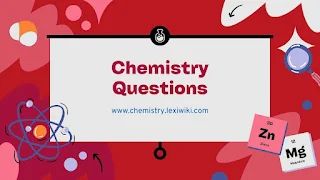Question on Combustion Reaction
Combustion Reaction – Multiple-Choice Questions
1. What is a combustion reaction?
A) A reaction involving acids and bases
B) A reaction where a substance combines with oxygen, releasing energy
C) A decomposition of water
D) A redox reaction involving a metal
E) A precipitation reaction
2. What are the typical products of the complete combustion of a hydrocarbon?
A) CO₂ and H₂O
B) CO and H₂
C) CH₄ and O₂
D) H₂ and O₂
E) C and H₂O
3. Which of the following is a correct example of a combustion reaction?
A) 2H₂ + O₂ → 2H₂O
B) CH₄ + 2O₂ → CO₂ + 2H₂O
C) CaCO₃ → CaO + CO₂
D) NaOH + HCl → NaCl + H₂O
E) Zn + CuSO₄ → ZnSO₄ + Cu
4. What is always a reactant in a combustion reaction?
A) Hydrogen
B) Nitrogen
C) Oxygen
D) Carbon
E) Sulfur
5. Incomplete combustion of hydrocarbons produces:
A) CO₂ and H₂O
B) C and H₂
C) CO and H₂O
D) O₃ and CO
E) CH₄ and O₂
6. Which of these fuels undergoes combustion?
A) CH₄
B) H₂
C) C₈H₁₈
D) All of the above
E) None of the above
7. Which of the following indicates incomplete combustion?
A) Blue flame
B) No residue
C) Soot formation
D) Sparkling water
E) Acidic products
8. What energy transformation occurs in a combustion reaction?
A) Electrical to chemical
B) Mechanical to chemical
C) Chemical to thermal
D) Thermal to chemical
E) Kinetic to light
9. Which gas is commonly produced during incomplete combustion and is toxic?
A) Carbon dioxide
B) Carbon monoxide
C) Oxygen
D) Hydrogen
E) Methane
10. Which of the following reactions is a combustion reaction?
A) C₂H₆ + O₂ → CO₂ + H₂O
B) H₂ + Cl₂ → 2HCl
C) NH₃ + HCl → NH₄Cl
D) Na + Cl₂ → NaCl
E) Zn + HCl → ZnCl₂ + H₂
11. What is needed to initiate a combustion reaction?
A) Catalyst
B) Light
C) Heat (activation energy)
D) Water
E) Base
12. What does the fire triangle consist of?
A) Carbon, oxygen, water
B) Heat, fuel, oxygen
C) Hydrogen, oxygen, carbon
D) Fuel, pressure, carbon
E) Air, hydrogen, carbon
13. What is the main source of energy in combustion reactions?
A) Nuclear fission
B) Breaking covalent bonds
C) Forming stronger bonds in products
D) Electrons transfer
E) Absorption of heat
14. Which of the following hydrocarbons will produce more CO₂ during complete combustion?
A) CH₄
B) C₂H₆
C) C₃H₈
D) C₄H₁₀
E) C₈H₁₈
15. Which of the following represents the balanced combustion of ethane (C₂H₆)?
A) C₂H₆ + O₂ → CO₂ + H₂O
B) 2C₂H₆ + 7O₂ → 4CO₂ + 6H₂O
C) C₂H₆ + 3O₂ → 2CO₂ + 3H₂O
D) 2C₂H₆ + 5O₂ → 4CO + 6H₂O
E) C₂H₆ + 2O₂ → CO + H₂O
16. Which of the following substances is NOT typically involved in a combustion reaction?
A) O₂
B) CH₄
C) CO₂
D) C₈H₁₈
E) C₂H₂
17. In combustion, why is oxygen essential?
A) It dissolves hydrocarbons
B) It prevents explosions
C) It provides energy
D) It acts as an oxidizer to release energy
E) It produces water
18. What environmental issue is most associated with incomplete combustion?
A) Acid rain
B) Ozone depletion
C) Carbon monoxide poisoning
D) Water pollution
E) Global warming
19. What is the balanced chemical equation for the combustion of propane (C₃H₈)?
A) C₃H₈ + 3O₂ → 3CO₂ + 4H₂O
B) C₃H₈ + 5O₂ → 3CO₂ + 4H₂O
C) 2C₃H₈ + 7O₂ → 6CO₂ + 8H₂O
D) 2C₃H₈ + 5O₂ → 6CO₂ + 6H₂O
E) C₃H₈ + O₂ → CO₂ + H₂O
20. What is the primary use of combustion reactions in daily life?
A) Synthesizing drugs
B) Generating energy in engines and heaters
C) Neutralizing acids
D) Producing plastics
E) Electroplating metals
- Questions on Balancing Chemical Equations
- Questions on Combination Reactions
- Questions on Decomposition Reactions
Answer Key with Explanations
1. B – Combustion involves reaction with oxygen and releases heat/light.
2. A – Complete combustion of hydrocarbons produces CO₂ and H₂O.
3. B – This is the combustion of methane, a classic hydrocarbon.
4. C – Oxygen is always required in combustion.
5. C – Incomplete combustion produces CO (toxic) and H₂O.
6. D – All listed substances are fuels and undergo combustion.
7. C – Incomplete combustion produces soot (carbon).
8. C – Combustion releases chemical energy as heat.
9. B – CO is a dangerous gas formed during incomplete combustion.
10. A – Hydrocarbon + O₂ → CO₂ + H₂O is combustion.
11. C – Heat (activation energy) is necessary to start combustion.
12. B – The fire triangle consists of heat, fuel, and oxygen.
13. C – Energy comes from forming strong bonds in CO₂ and H₂O.
14. E – C₈H₁₈ has more carbon atoms, hence more CO₂ on combustion.
15. B – This is the correctly balanced equation for ethane combustion.
16. C – CO₂ is a product, not a reactant, in combustion.
17. D – Oxygen oxidizes fuel, releasing energy.
18. C – Incomplete combustion leads to CO, causing poisoning.
19. B – Balanced: C₃H₈ + 5O₂ → 3CO₂ + 4H₂O.
20. B – Combustion powers engines and provides heating.
Dive into the groundbreaking science of neurotransmitters—your brain’s invisible architects—in Chemical Harmony: How Neurotransmitters Shape Our Lives (2025). This meticulously researched book reveals how serotonin, dopamine, GABA, and other brain chemicals silently orchestrate every aspect of your existence, from decision-making and relationships to mental health and emotional resilience.Click here to buy
Share Online!

